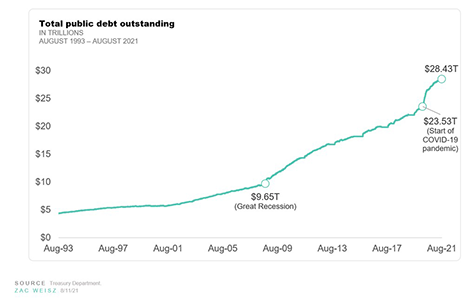The debt ceiling, or debt limit, is the maximum amount of money that the federal government can borrow to meet its existing legal obligations. In 1917, the debt ceiling was created by Congress via the Second Liberty Bond Act. Prior to the creation of the debt ceiling, there were parliamentary limitations on the amount of debt that the government could issue.
Except for about a year during 1835–1836, the United States has continuously had a fluctuating public debt. The national debt has increased under every presidential administration since Herbert Hoover. The United States has raised its debt ceiling at least 90 times in the 20th century. It has never been reduced. Since 1962 until 2011, the debt ceiling was raised 74 times, including 18 times under former President Ronald Reagan, eight times under former President Bill Clinton, seven times under former President George W. Bush, and five times under former President Barack Obama. From 2001, Congress has raised the debt ceiling 14 times from 2001 to 2016. The debt ceiling was raised roughly a total of $5.4 billion during President George W. Bush’s tenure, and it was raised roughly a total of $6.5 during President Obama’s tenure.
 If government hits the debt ceiling and exhausts all other options, it can no longer borrow. Since the government runs an annual deficit, it will run out of money soon after it hits the limit and temporarily default on obligations. If the Treasury Department is not able to borrow additional money, the United States could default on outstanding loans and its credit rating may be downgraded by credit rating groups. A default would negatively impact the U.S. economy and international financial markets.
If government hits the debt ceiling and exhausts all other options, it can no longer borrow. Since the government runs an annual deficit, it will run out of money soon after it hits the limit and temporarily default on obligations. If the Treasury Department is not able to borrow additional money, the United States could default on outstanding loans and its credit rating may be downgraded by credit rating groups. A default would negatively impact the U.S. economy and international financial markets.
Current State of Play
The Bipartisan Budget Act of 2019 suspended the ceiling until July 31, 2021. The debt limit was set at $22.0 trillion when Congress passed the bill. Since the lapse, the debt limit has thus been reset to its previous ceiling, plus the amount it borrowed since the ceiling was suspended, which was $6.5 trillion as of June 30, 2021. On August 1, 2021, the debt limit was set at roughly $28.5 trillion.
Democrats have been hoping to have Republicans to join them in approving a long-term debt ceiling. However, Republicans have resisted and continued to insist Democrats could do it on their own through budget reconciliation. Democrats maintained they did not have time to do so before the October 18th deadline.
So late this week, Democrats accepted an offer from Senator McConnell to increase the debt limit through early December. Following Senate passage, a House vote is expected early next week. McConnell argues this will give Democrats the time they say is needed to increase it via reconciliation. Democrats say McConnell fold and insist they still won’t take this employ reconciliation. Another showdown looms in December – just as the short-term government funding extension is also set to expire.